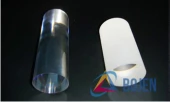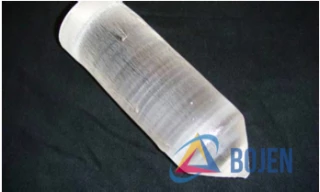Description
Bismuth Germanate (BGO) - Bi4Ge3O12 is a remarkable inorganic oxide known for its crystalline cubic eulytine structure. This material is colorless, transparent, and insoluble in water, making it a highly stable component for various scientific applications. Its unique properties are highlighted when it is exposed to high-energy particles or radiation sources such as gamma rays and X-rays, where it emits a distinct green fluorescent light with a peak wavelength of 480 nm.
BGO is renowned for its high stopping power and scintillation efficiency, which makes it an excellent choice for scintillation materials. Additionally, it offers good energy resolution and is non-hygroscopic, further enhancing its utility in demanding environments. These attributes have established BGO as a valuable material across a broad spectrum of fields including high energy physics, nuclear physics, space physics, nuclear medicine, and geological exploration.
With a density of 7.13 g/cm3, a radiation length of 1.12 cm, and a decay constant of 0.3 μs, BGO demonstrates impressive physical characteristics. Its emission peak at 480 nm and light yield at 8% relative to NaI:Tl further underscore its effectiveness. The material boasts a melting point of 1050°C and a hardness of 5 on the Mohs scale, with a refractive index of 2.15. Notably, BGO is non-hygroscopic and lacks cleavage, ensuring its durability and reliability in various applications.
Bismuth Germanate BGO Special Components
Specifications
| Radiation Length: | 11.2 mm |
|---|---|
| Decay Time Constant: | 300 ns |
| Emission Peak: | 480 nm |
| Scratch & Dig: | 80/50 |
| Density: | 7.13 g/cm³ |
| Light Yield: | 8 %NaI:Tl |
| Melting Point: | 1050 °C |
| Hardness: | 5 Mho |
| Refractive Index: | 2.15 |
| Hygroscopicity: | none |
| Cleavage: | none |
Features
- Material: Bismuth Germanate (BGO) - Bi4Ge3O12, a crystalline inorganic oxide with a cubic eulytine structure.
- Appearance: Colorless, transparent, and insoluble in water.
- Scintillation Properties: Emits green fluorescent light with a peak wavelength of 480 nm when exposed to high energy particles or gamma/X-rays.
- High Stopping Power: Ideal for applications requiring efficient energy resolution.
- Non-Hygroscopic: Does not absorb moisture, ensuring durability in various environments.
Applications
- High Energy Physics: BGO is used in experiments and applications involving high energy particles due to its high stopping power and scintillation efficiency.
- Nuclear Physics: Its properties make it suitable for detecting and measuring nuclear radiation.
- Space Physics: BGO is employed in space missions to detect cosmic rays and other high-energy particles.
- Nuclear Medicine: It is used in medical imaging equipment, such as PET scanners, to detect gamma rays emitted by radioactive tracers.
- Geological Exploration: BGO helps in exploring geological formations by detecting radiation from natural sources.
- Other Industries: Its unique properties allow it to be used in various other industrial applications where radiation detection is required.
Frequently Asked Questions
What is Bismuth germinate (BGO)?
What are the applications of BGO?
What is the density of BGO?
Is BGO a hygroscopic material?
What is the melting point of BGO?
Similar Products
Your inquiry has been received.
Create an account by adding a password
Why create an account?
- Auto-complete inquiry forms
- View and manage all your past messages
- Save products to your favorites
- Close your account anytime — no hassle

